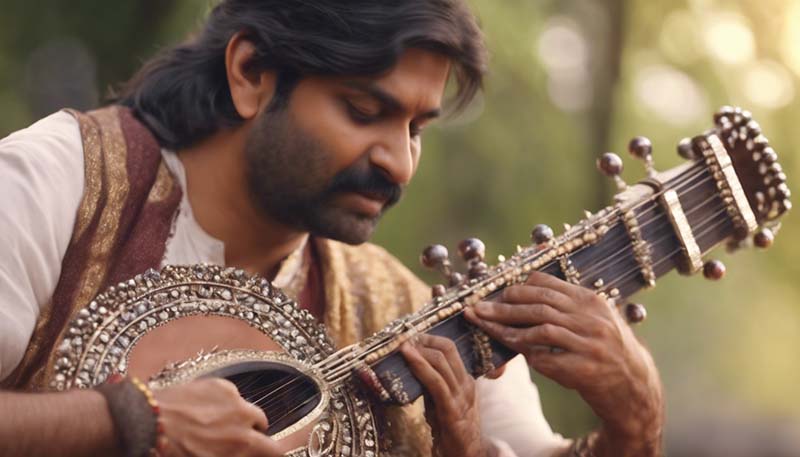The Role of the Sitar in Indian Classical Music
The Role of the Sitar in Indian Classical Music
Indian classical music is a genre that has been passed down through generations, with a rich history and a deep cultural significance. Among the many instruments that contribute to its unique sound, the sitar holds a special place. This article explores the role of the sitar in Indian classical music, its history, the techniques used to play it, and its influence on the world music scene.
Introduction to the Sitar
The sitar is a plucked stringed instrument used primarily in Indian classical music and has been an essential part of the Hindustani classical tradition since the 18th century. It is believed to have evolved from the veena, an ancient stringed instrument mentioned in Hindu scriptures. The sitar is known for its rich, resonant sound and its ability to produce sustained notes, which is crucial for the intricate melodic lines and improvisations characteristic of Indian classical music.
Historical Evolution of the Sitar
The exact origins of the sitar are not well-documented, but it is thought to have been developed by combining features of several instruments. The name "sitar" is derived from two Persian words: "si" meaning three (referring to the three main melody strings) and "tar" meaning string. Over time, the sitar has undergone various modifications, with the most notable being the addition of sympathetic strings, which resonate in response to the main strings, enriching the overall sound.
Advertisement
Structure and Mechanics of the Sitar
The sitar consists of a large, round, wooden resonator, a long fretted neck, and a number of strings. There are typically seven main strings (three melody strings and four sympathetic strings), with the main strings being plucked with the index finger and thumb, while the pinky finger presses the frets. The sympathetic strings run underneath the frets and vibrate in response to the main strings, creating a harmonic texture.
Playing Techniques
The sitar is played by sitting with the instrument resting on the floor, with the resonator in the lap and the neck extending over the right shoulder. The player uses a plectrum attached to the index finger and thumb of the right hand to pluck the strings. The left hand is used to press the strings against the frets to change the pitch. The sitar can produce a wide range of sounds, from the softest whisper to the loudest roar, depending on the player’s technique.
The Role of the Sitar in Indian Classical Music
In Indian classical music, the sitar is often the main melodic instrument, leading the performance with the tabla, a pair of hand drums that provide the rhythmic accompaniment. The sitar player, or sitarist, is expected to have a deep understanding of raga (melodic framework) and tala (rhythmic cycle), as the music is largely improvised around these structures.
Raga and Tala
The sitar is particularly suited to the exploration of ragas, which are scales and melodies that evoke certain emotions and are associated with specific times of the day or year. The sitarist will often begin a performance with an alap, a slow, unmetered improvisation that explores the raga in depth, gradually building up to the faster sections that follow.
Famous Sitarists and Their Impact
Throughout history, several sitarists have gained international recognition for their mastery of the instrument and their contributions to Indian classical music. One of the most famous is Ravi Shankar, who not only was a virtuoso sitarist but also played a significant role in popularizing Indian music in the Western world. His student, George Harrison of The Beatles, further introduced the sitar to a global audience through the band’s music.
Ravi Shankar's Influence
Ravi Shankar’s influence extended beyond his performances. He was a dedicated teacher and composed numerous works for the sitar, expanding its repertoire. His collaborations with Western musicians, such as the legendary concert with violinist Yehudi Menuhin, showcased the versatility of the sitar and the potential for cross-cultural fusion.
The Sitar in Fusion and World Music
The sitar’s distinctive sound has made it a popular choice for musicians exploring fusion genres. Its presence in rock, jazz, and world music has broadened its appeal and demonstrated its adaptability. The instrument's ability to blend with other musical traditions while retaining its unique character has made it a symbol of cultural exchange.

Contemporary Sitarists
In contemporary music, the sitar continues to be a significant instrument, with artists like Anoushka Shankar (Ravi Shankar’s daughter), Ustad Amjad Ali Khan, and U. Srinivas pushing the boundaries of traditional Indian classical music and incorporating the sitar into new styles and genres.
Conclusion
The sitar remains a vital instrument in Indian classical music, with its capacity to convey the subtleties of raga and the intricacies of tala. Its journey from a traditional instrument to a symbol of cultural fusion reflects the dynamic nature of music and its ability to transcend geographical and cultural boundaries. As Indian classical music continues to evolve, the sitar is poised to play an even more significant role in the global music scene.